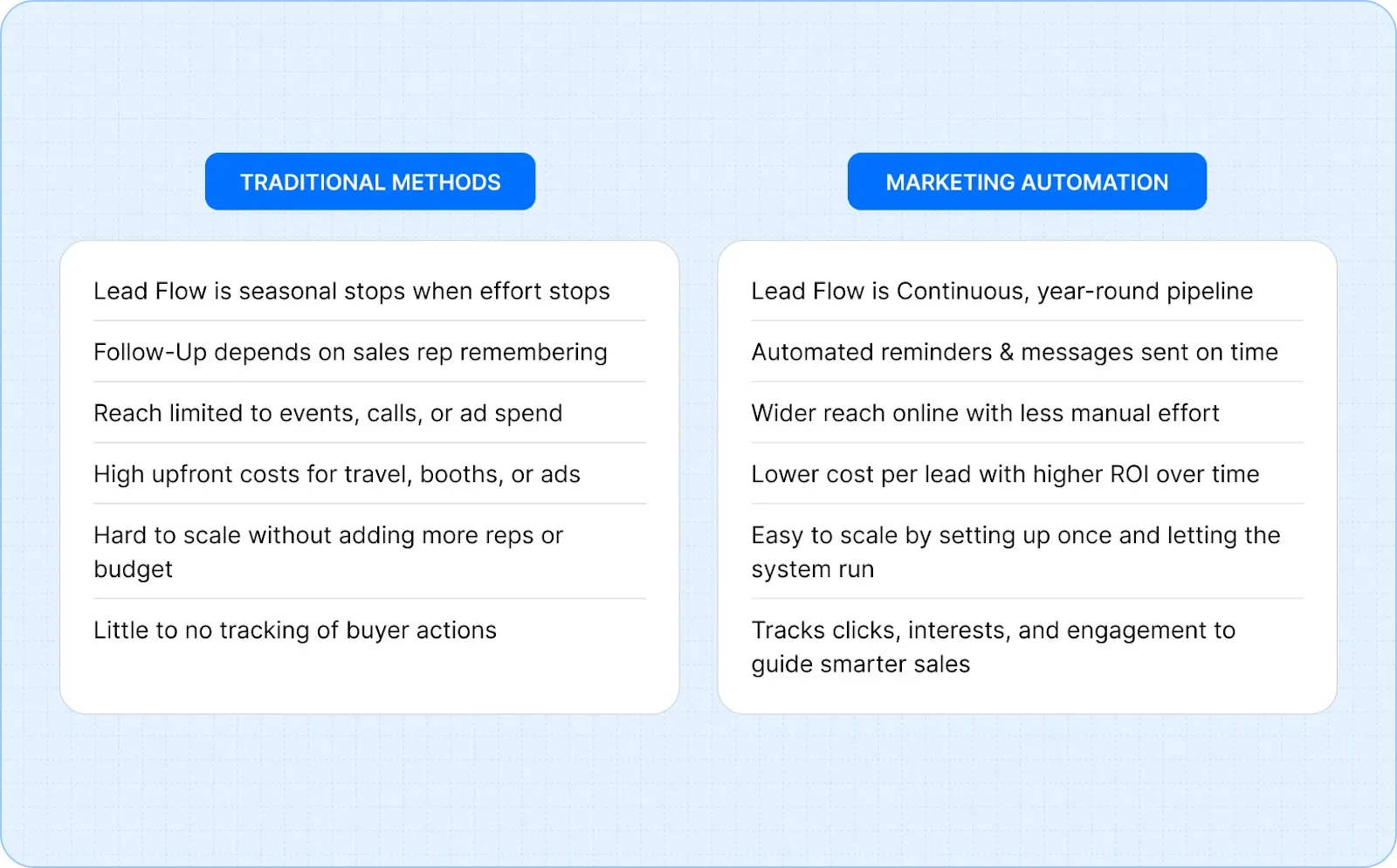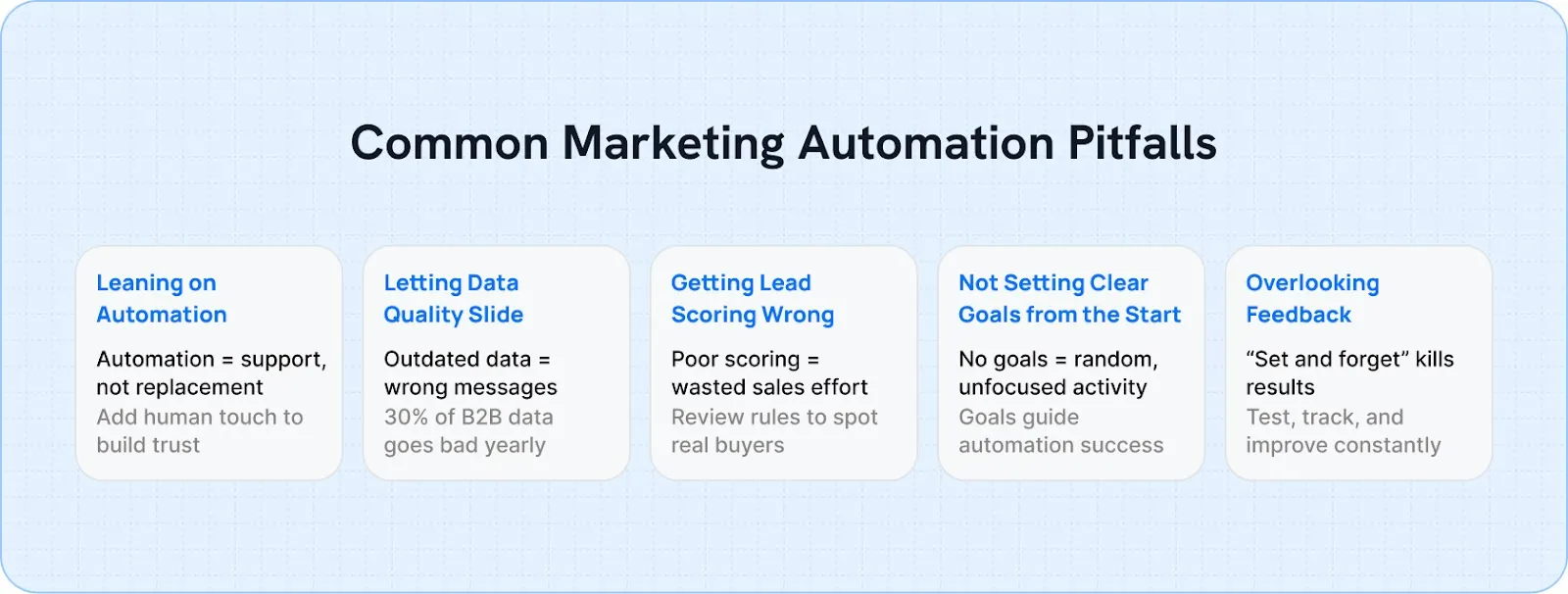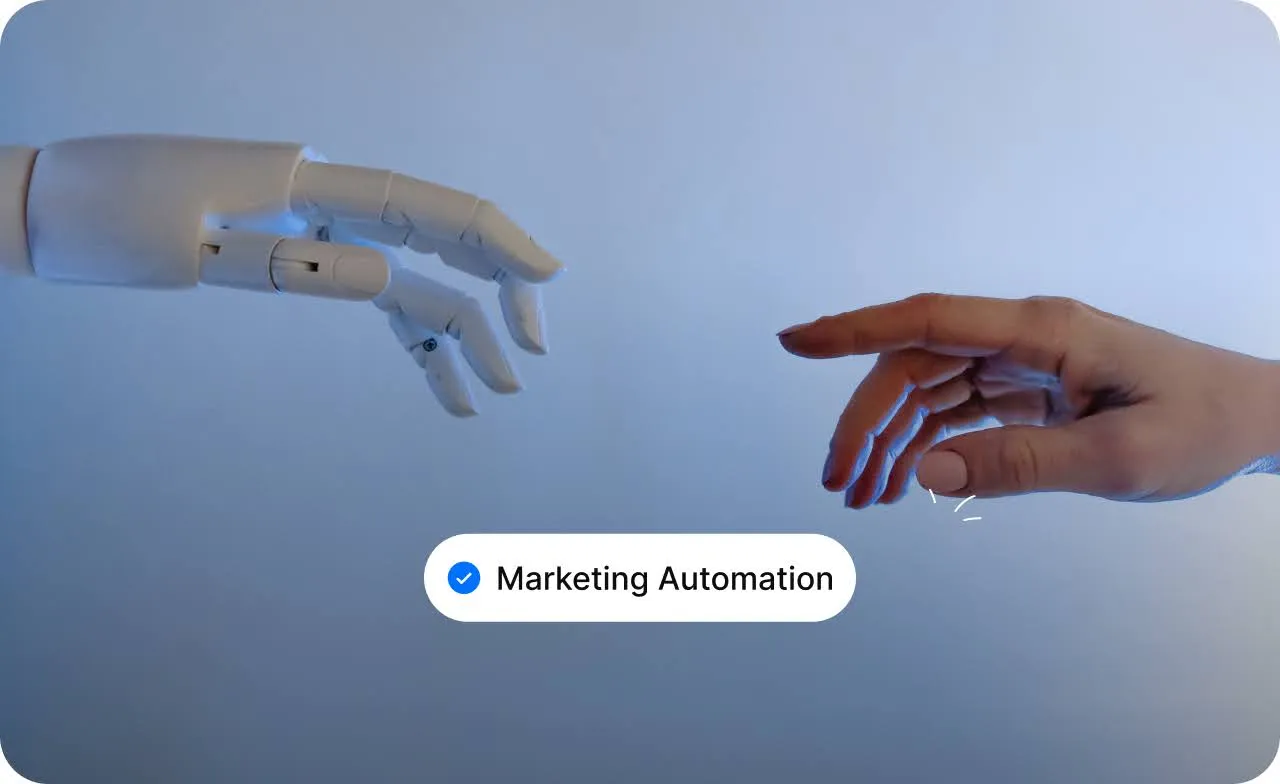You already know how much effort it takes to get a new customer. Trade shows, phone calls, and even running ads all work, but they demand constant time, energy, and money. Once you stop, the leads dry up. That’s why so many manufacturers and distributors feel like they’re always chasing the next deal instead of building a steady pipeline.
This is where marketing automation takes the stage for the manufacturing ecosystem. Think of it as a set of tools that quietly work in the background, nurturing prospects, following up at the right time, and helping your sales team stay focused on closing deals instead of chasing them.
In this guide, we’ll break down marketing automation in the simplest terms, show how it fits alongside the methods you already trust, and explain how it can create a continuous flow of qualified leads for your business throughout the year.
TL;DR:
- Marketing automation for manufacturing turns unpredictable sales into a steady, year-round pipeline.
- It helps capture, nurture, and segment leads while supporting sales teams with timely follow-ups.
- It automates repetitive tasks like landing pages, analytics, and reporting for smarter decisions.
- It boosts ROI, reduces costs, and frees sales reps to focus on closing deals instead of chasing them.
What Marketing Automation Really Means for Manufacturers
When you hear the phrase marketing automation, it might sound like another fancy software term. But for manufacturers, it’s much simpler than that. It means,
- Handling Repetitive Marketing Tasks
At its core, marketing automation is about setting up tools that handle repetitive marketing tasks for you, things like sending follow-up emails, reminding prospects about your products, or keeping track of who showed interest in your website. Instead of relying only on one sales rep to remember every call or follow-up, automation makes sure no lead slips through the cracks.
- Being Your Customer’s Support
Think of it as a support system for your sales team. While your reps focus on building relationships and closing deals, automation quietly works in the background, collecting inquiries, sending timely messages, and warming up prospects until they’re ready to talk to you.
- Scaling Your Growth
And here’s the important part: it’s not just about using new technology. For a manufacturer, marketing automation is a growth tool. It helps you scale your efforts so that leads keep flowing in even when trade shows are months away or your sales team is stretched thin.
In short, marketing automation for manufacturing means building a reliable process that brings in more opportunities without replacing the methods you already trust.
So, why is it better than the traditional methods? Let’s find out.
Manufacturing Marketing: Automation vs. Traditional Methods

Traditional methods like trade shows, cold calls, and ads have their place, but they often stop producing results once the effort or budget ends. Marketing automation, on the other hand, keeps the process running in the background so your business can keep building leads. Here’s a simple comparison:
Why Marketing Automation Is a Game Changer for Manufacturing Growth
Growth in manufacturing often depends on finding new customers while keeping existing ones engaged. But relying only on trade shows, phone calls, or ads can make this growth unpredictable. Marketing automation changes that by creating a steady, reliable system that supports your sales team and keeps leads moving forward.
Boost Your Revenue Faster Than Before
Marketing automation helps you keep leads warm until they’re ready to buy. Instead of missing out because someone forgot to follow up, the system makes sure every prospect stays engaged. This consistent attention often turns into faster deals and more sales.

Align Marketing and Sales to Work as One Team
Many times, marketing and sales operate separately, which creates gaps. Automation brings both together by sharing the same data, so your sales reps know exactly which leads are most interested. This way, your team works as one unit with the same goal.

Deliver Marketing That Truly Connects with Customers
Customers respond best when you talk about their needs at the right time. Automation sends out messages that feel timely and relevant, rather than random blasts. This builds stronger connections and keeps your company in their mind.

Build a Stronger Brand Reputation That Lasts
Consistent communication creates trust. With automation, your company can regularly show up in front of potential buyers, not just during trade shows. Over time, this steady presence strengthens your brand reputation.

Scale Your Market Reach Without Extra Stress
Reaching more people usually means hiring more staff or working longer hours. Automation changes that by handling routine outreach automatically. You get more reach without burning out your team or stretching your budget.

Cut Costs While Increasing Impact
Traditional marketing often requires high spending on ads or travel. Automation lowers those costs by focusing your efforts on the leads most likely to convert. You spend less while getting better results.

Use Your Team’s Time and Energy More Wisely
Instead of spending hours chasing unqualified leads, your sales team can focus on serious buyers. Automation filters the noise and highlights the best prospects. This makes your team’s workday more productive and rewarding.

Get More Leads and Make Every Lead Count
Marketing automation doesn’t just bring in more leads, it ensures each one is followed up properly. No more lost opportunities because someone got busy. Every lead gets attention, increasing your chances of winning business.

Know Your Buyers Better to Sell Smarter
Automation collects useful data on how buyers interact with your company. You learn what they click, read, or request, giving you insights into what matters most to them. Armed with this knowledge, your sales team can pitch smarter and close faster.

Tasks That Can Be Automated: Examples of Marketing Automation For Manufacturers
Marketing automation is not about replacing your sales team, it’s about taking the repetitive tasks off their shoulders so they can focus on real conversations and closing deals. Here are some common tasks manufacturers can automate to keep leads flowing and customers engaged.
Lead Generation: Instantly Capture Website Inquiries Into Your CRM

Instead of waiting only for trade shows or calls, automation can capture inquiries from your website 24/7. For example, when someone downloads a brochure or fills out a quote request, the system automatically records them as a lead. This way, you don’t lose potential customers who are searching online outside business hours.
Lead Nurturing & Personalization: Trigger Personalized Follow-Up Email Sequences

Many prospects aren’t ready to buy right away. Automation gives you the insights that you need to send personalized follow-up emails with useful information, like product guides or industry updates, based on what they showed interest in. Over time, this builds trust and keeps your brand top of mind until they’re ready to move forward.
Lead Management: Automatically Sort Leads Based on Behavior and Search Data

Not every lead is the same. Automation tools can group your leads into categories—such as small buyers, bulk buyers, or repeat customers—based on their actions and details.
Even SEO data can help here.
For example, if a lead came to your site by searching “bulk steel fasteners supplier,” you know they’re likely a large buyer, while someone searching “small stainless bolts for DIY” may be a smaller customer. By combining SEO insights with automation, your sales team can focus their time on the most promising opportunities instead of chasing mismatched leads.
Landing Page Optimization: Run Continuous A/B Tests on Page Versions

A landing page, as you’d know, is simply a page on your website built for a specific product, service, or campaign. With automation, you can test different versions of these pages, like trying two headlines or two “Request a Quote” buttons to see which one brings in more leads. The system tracks results automatically so you know what works best.
Supply Chain Communication: Send Instant Supplier Alerts and Order Updates

Keeping suppliers and distributors updated often eats up valuable time. Automation can take over routine touchpoints, like order confirmations, shipment tracking, and restock alerts, so nothing is missed. For example, if raw material inventory dips below a set level, the system instantly notifies both your team and the supplier, ensuring smooth supply flow without constant phone calls.
Compliance & Documentation: Schedule Smart Compliance Reminders and Generate Reports
Manufacturers operate in a space where compliance deadlines and audit trails can’t be ignored. Automation makes this process stress-free by storing key documents, sending renewal reminders, and generating compliance-ready reports. Instead of chasing paperwork, your team gets timely alerts, whether it’s for ISO, OSHA, or internal quality checks—keeping you audit-ready at all times.
Technical Support Integration: Route Support Tickets to the Right Technician Instantly

When customers face technical issues, a fast response builds confidence. Automation ensures that support requests move seamlessly: an inquiry from your website can automatically create a ticket, trigger an acknowledgment email, and assign it to the right technician. This keeps customers reassured while your team resolves problems quickly and efficiently.
Analytics & Reporting: Generate Real-Time Performance Reports and Metrics
Instead of guessing what’s working, automation tools show you clear numbers: how many people opened your emails, clicked on your product pages, or filled out a form. This gives you a full picture of what’s bringing results and where to adjust. It helps you make smarter decisions with facts, not hunches.

A comprehensive table to understand better:
How can we actually incorporate this into the manufacturing process? Let’s read to find out.
How to Incorporate Marketing Automation into Manufacturing Processes
How to Bring Marketing Automation Into Your Manufacturing Process
1. Set Clear Goals:
Start by defining exactly what you want marketing automation to achieve for your business.
Use Case Example: A CNC machining company set a goal to increase quote requests by 25% within six months. They built automated forms on their website that connected directly to their sales team’s inbox. Every time a new form was filled, the sales team received instant alerts, no delays, no missed leads.
2. Take a Close Look at Your Current Marketing:
Review your existing marketing efforts to find the areas where automation can make the biggest difference. Our manufacturing marketing audit checklist can help with this.
Use Case Example: An industrial valve manufacturer realized that 70% of their cold calls weren’t reaching the right people. By auditing their process, they saw that website visitors often left without filling out the contact form. With automation, they added a pop-up offering a spec sheet in exchange for an email. Suddenly, they had 300+ new contacts each month.
3. Pick the Right Marketing Automation Platform:
Choose a tool that matches your needs - think ease of use, how well it connects with your other systems, and how easily it can grow with you.
Use Case Example: A plastics distributor picked HubSpot because it connected smoothly with their existing Salesforce CRM. Every inquiry from the website went directly into their CRM, with automated reminders for the sales team to follow up. No more leads slipping through the cracks.
4. Clean Up and Organize Your Data:
Make sure your customer info is accurate, current, and sorted so automated campaigns hit the right targets.
Use Case Example: A bearings manufacturer had 8,000 contacts but half were duplicates or outdated. After cleaning the list, automation emails went only to verified, active buyers. Open rates doubled from 15% to 32% because the messages finally reached the right audience.
5. Map Out Your Automation Plan:
Create a clear strategy for which tasks you’ll automate and at what points along the customer journey.
Use Case Example: A sheet metal fabricator mapped out an email sequence for prospects who downloaded their “Capabilities Brochure.” Day 1: send a thank-you email. Day 3: share a customer success story. Day 7: invite them to request a quote. Within two months, they saw a 20% increase in RFQ submissions.
6. Build Your Automated Workflows:
With your plan ready, set up workflows that run in the background. Think of these as rules: “If a buyer does X, then send them Y”. This would handle repetitive tasks automatically.
Use Case Example: A packaging equipment maker set up a workflow: if someone visited their “Shrink Wrapping Machines” page twice, they automatically received an email offering a product demo. This simple rule turned website browsers into sales meetings.
7. Launch, Track, and Improve:
Turn on your automation, watch key results, and make tweaks as needed to get the best return on your investment.
Use Case Example: A precision tools supplier launched their first automated campaign and saw only a 12% open rate. By adjusting subject lines to focus on buyer pain points (“Cut Tool Downtime in Half”), their open rate jumped to 28%. Continuous improvement made the difference.
Common Marketing Automation Pitfalls to Watch Out For
Marketing automation can save time and keep leads moving, but it only works well when the basics are handled. Think of it like a power tool that needs the right settings and a steady hand. If goals are unclear or data is messy, results will suffer. Below are the common slips to watch for and simple ways to avoid them.

1. Leaning Too Much on Automation Alone
Automation works best when paired with human judgment. If you rely only on the system without sales reps adding their personal touch, prospects may feel ignored or treated like numbers. Think of automation as a helper, not a replacement.
2. Letting Data Quality Slide
If your customer data is outdated or incorrect, automation will send the wrong messages to the wrong people. For manufacturers, this can mean sending product updates to old contacts who no longer work at the company. Clean and updated data keeps automation effective.
3. Getting Lead Scoring Wrong
Lead scoring helps your team know which prospects are worth the most attention. But if you set the rules poorly, strong leads may get overlooked while weak ones take up your time. It’s important to review and adjust scoring regularly to match your sales priorities.
4. Not Setting Clear Goals from the Start
Without clear goals, automation can feel like random activity. Are you trying to drive more RFQs, book product demos, or build awareness? Setting specific goals at the start makes sure automation actually supports your business growth instead of just running in the background.
5. Overlooking Feedback and Skipping Optimization
Automation is not “set it and forget it.” You need to track results, listen to customer responses, and fine-tune campaigns. For example, if no one opens your follow-up emails, maybe the subject lines need improvement. Feedback is what turns automation into real results.
While staying vigilant to avoid these pitfalls is ideal, knowing how to resolve them, if a case arises is what will propel you to success.
Also Read: The B2B Manufacturing Marketing System: Build Visibility, Trust, and Sales
How Automation Helps You Work Less and Sell More
We’ve seen how marketing automation helps manufacturers capture leads 24/7, nurture them with the right information, and keep sales teams focused on the most promising opportunities. It simplifies repetitive work, improves communication with suppliers and customers, and gives you real-time data to make smarter decisions. In short, automation makes growth more predictable and less dependent on chance.
This is exactly where Gushwork can support you. By taking care of repetitive tasks, building workflows that run in the background, and showing you clear insights on what’s working, they make sure your sales team spends more time closing deals and less time chasing them. The result? A steady pipeline of leads and a stronger return on your marketing efforts.
Book a demo with Gushwork today and see how automation can keep your business growing all year round.
FAQs
1. What is the biggest challenge manufacturers face with marketing automation?
Aligning sales and marketing teams while managing quality data is often the toughest hurdle.
2. Can small manufacturing businesses benefit from marketing automation?
Absolutely, automation can streamline processes and boost leads at any company size.
3. How quickly can manufacturers see results after automating marketing?
Many see improvements in lead generation and engagement within a few months.
4. Does marketing automation replace personal sales efforts in manufacturing?
No, it complements sales by nurturing leads and freeing up reps to focus on closing deals.
5. What role does data play in marketing automation success?
Clean, organized data drives smarter targeting, personalization, and better ROI.


















.webp)








.webp)




.svg)







.svg)